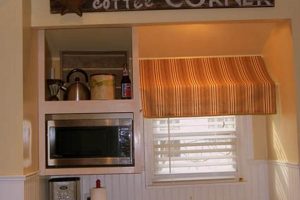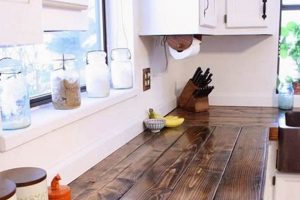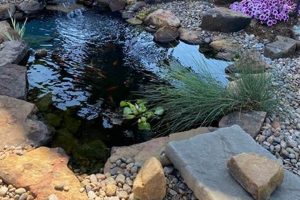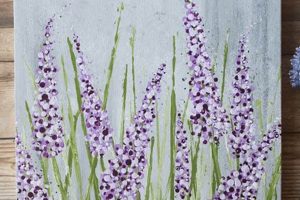Constructions intended to hold soil for growing plants, created by individuals using readily available materials and tools, represent a common form of gardening. These containers provide a contained environment for cultivating flowers, vegetables, or herbs, offering flexibility in placement and design. For example, repurposed wooden pallets can be transformed into tiered structures for vertical gardens, or concrete blocks can be stacked to create simple, functional growing spaces.
The advantages of such projects extend beyond mere aesthetics. They allow for gardening in areas with poor soil quality, limited space, or restricted access to ground-level planting. Historically, resourceful individuals have utilized found objects to create growing spaces, demonstrating both ingenuity and a connection to nature. This approach promotes sustainability through the reuse of materials and offers cost-effective solutions for individuals seeking to enhance their living environments with greenery.
The following discussion explores various material options, design considerations, and construction techniques relevant to creating personalized plant containers. Considerations include the selection of appropriate lumber, proper drainage implementation, and suitable finishing techniques to ensure longevity and optimal plant health. Subsequent sections will delve into specific project examples, providing detailed instructions and visual guidance for successful implementation.
Essential Considerations for Constructing Plant Containers
The subsequent guidelines offer crucial advice for achieving optimal results when undertaking personalized container projects. Proper planning and execution are paramount to ensure longevity, functionality, and aesthetic appeal.
Tip 1: Material Selection: Consider rot-resistant wood species such as cedar, redwood, or cypress for extended lifespan. If using treated lumber, ensure it is safe for plant contact, particularly when growing edible plants. Avoid reusing materials that may contain harmful chemicals or contaminants.
Tip 2: Drainage Implementation: Adequate drainage is essential to prevent waterlogged soil and root rot. Drill sufficient drainage holes in the bottom of the container, and consider adding a layer of gravel or landscape fabric to prevent soil from clogging the openings.
Tip 3: Size and Depth Considerations: The size and depth of the container should be appropriate for the plants being cultivated. Larger plants require more space for root development. Research the specific needs of the intended plants before commencing construction.
Tip 4: Soil Composition: Utilize a well-draining potting mix formulated for container gardening. Avoid using garden soil, as it can compact and hinder drainage. Incorporate slow-release fertilizer to provide essential nutrients over time.
Tip 5: Structural Integrity: Reinforce corners and joints with screws or bolts for added stability. Consider adding internal bracing for larger containers to prevent bowing or warping over time.
Tip 6: Liner Usage: Employ a plastic liner to protect the wood from moisture and prolong its lifespan. Ensure the liner has drainage holes to allow excess water to escape.
Tip 7: Location Assessment: Before constructing, determine the intended location of the finished container. Consider sunlight exposure, accessibility for watering, and potential weight restrictions. Construct the container in situ if it is too heavy to move once filled.
Careful consideration of these tips will significantly enhance the functionality and durability of customized growing spaces. The resulting structures will provide an ideal environment for plants to thrive, contributing to a more aesthetically pleasing and sustainable environment.
The final section will present project ideas, designed with the principles outlined above in mind.
1. Material Durability
Material durability represents a pivotal factor in the longevity and overall success of personalized plant container projects. The selected material dictates the container’s resistance to environmental stressors, including moisture, temperature fluctuations, and pest infestations, thereby directly impacting its lifespan and the health of the cultivated plants.
- Wood Species Selection
The choice of wood species significantly affects a container’s resistance to decay. Rot-resistant options like cedar, redwood, and cypress inherently withstand moisture damage, prolonging the container’s usability. In contrast, untreated softwoods are prone to rapid decomposition, necessitating more frequent replacements. Selecting appropriate wood thus represents a critical investment in the structure’s durability.
- Protective Coatings and Treatments
Application of protective coatings, such as paints, stains, or sealants, provides an additional barrier against moisture penetration and UV degradation. These treatments extend the lifespan of wood containers by minimizing water absorption and preventing sun-induced cracking or fading. However, the selection of plant-safe, non-toxic coatings is paramount, particularly when cultivating edible plants.
- Alternative Materials: Plastics and Composites
Beyond wood, durable plastics and composite materials offer viable alternatives. These materials are inherently resistant to rot and insect damage, requiring minimal maintenance. Recycled plastics contribute to sustainable practices, while composite materials offer a balance of durability and aesthetic appeal. However, the potential environmental impact of plastic production and disposal should be considered.
- Metal Corrosion Resistance
When metal is selected as materials, metal corrosion resistance should be a prime consideration. Untreated metals are prone to rust, reducing it’s structural strength and increasing it’s maintance costs. However, painting the metal or using special metal such as stainless steel can prevent rust.
The careful consideration of material durability translates directly into the sustained functionality and visual appeal of personalized plant growing spaces. Implementing the above facet considerations contributes to resource conservation by reducing the need for frequent replacements and promoting sustainable gardening practices.
2. Drainage Efficiency
Adequate drainage constitutes a critical element in the successful cultivation of plants within customized containers. Insufficient drainage leads to waterlogged soil, creating an anaerobic environment detrimental to root health. Root rot, caused by fungal pathogens thriving in overly moist conditions, represents a common consequence of inadequate water removal. For example, a container constructed from repurposed wood without proper drainage holes will inevita
bly accumulate excess water following rainfall or irrigation, increasing the risk of root rot and plant decline. Conversely, excessive drainage can lead to rapid soil drying and nutrient leaching, necessitating frequent watering and fertilization.
Implementing effective drainage solutions involves careful consideration of several factors. The number and size of drainage holes must be proportional to the container’s volume and the water-holding capacity of the potting mix. Incorporating a layer of coarse material, such as gravel or expanded clay pebbles, at the bottom of the container facilitates water flow away from the soil. Selecting a well-draining potting mix, composed of materials like peat moss, perlite, or vermiculite, further enhances water removal. The location of the container also influences drainage; placing a container on a permeable surface allows excess water to drain freely, whereas placing it on an impermeable surface can impede drainage and exacerbate waterlogging.
In summary, prioritizing drainage efficiency is essential for fostering healthy plant growth within personalized containers. Understanding the principles of water movement within the soil and implementing appropriate drainage solutions minimizes the risk of root rot and nutrient deficiencies. Furthermore, proper drainage management reduces the need for excessive watering, promoting water conservation and sustainable gardening practices. Neglecting drainage considerations can compromise plant health and negate the benefits of creating personalized growing spaces.
3. Structural Integrity
Structural integrity, defined as the ability to withstand applied forces without failure, represents a fundamental consideration in the design and construction of plant containers. Compromised structural integrity can lead to premature failure of the container, resulting in soil spillage, plant damage, and potential safety hazards. The following outlines key facets of structural integrity pertinent to personalized plant container design and construction.
- Joint Construction and Reinforcement
The method of joining individual components significantly impacts the overall strength and stability of the container. Weak joints represent common failure points. Employing robust fastening methods, such as screws, bolts, or mortise and tenon joints, enhances joint strength. Reinforcing corners and edges with metal brackets or additional wood supports further enhances structural integrity, particularly for larger or heavily loaded containers. An example of poor joint construction would be simply gluing butt joints together, this would lead to a quickly destabilized structure that is unable to retain its load.
- Material Thickness and Load-Bearing Capacity
The thickness of the material used in construction directly influences the container’s load-bearing capacity. Insufficient material thickness can result in bowing, warping, or even collapse under the weight of soil and plants. Selecting materials with adequate thickness and strength for the intended load is crucial. For example, a container constructed from thin, repurposed pallets may not be able to withstand the weight of saturated soil, whereas a container built from thicker lumber will provide greater structural stability.
- Base Support and Weight Distribution
The design of the base and the method of weight distribution influence the container’s stability and resistance to tipping. A wide, stable base provides greater resistance to overturning, particularly in windy conditions or on uneven surfaces. Distributing the weight evenly across the base reduces stress on individual support points. For example, placing a heavy container on a single, narrow support can create excessive stress, leading to failure. Distributing the weight across multiple supports or a solid base provides greater stability.
- Environmental Resistance and Material Degradation
Exposure to environmental factors, such as moisture, sunlight, and temperature fluctuations, can degrade construction materials over time, weakening the overall structure. Selecting weather-resistant materials and applying protective coatings can mitigate material degradation and extend the container’s lifespan. Neglecting environmental resistance can lead to premature failure, even with otherwise sound construction techniques. For example, an unsealed wood container exposed to constant moisture will eventually rot, compromising its structural integrity.
The foregoing considerations highlight the crucial relationship between structural integrity and the long-term viability of personalized plant containers. Implementing sound construction practices, selecting appropriate materials, and addressing environmental factors are essential for creating durable and functional growing spaces. Prioritizing structural integrity not only enhances the container’s lifespan but also ensures the safety and well-being of surrounding plants and individuals.
4. Size Appropriateness
Size appropriateness in plant containers directly influences plant health and vigor. A mismatch between container dimensions and plant growth requirements can lead to restricted root development, nutrient deficiencies, and ultimately, plant stress. When conceiving plant containers, the mature size of the intended plant species must be considered. Insufficient container volume limits root expansion, impeding the uptake of water and nutrients essential for optimal growth. Conversely, excessively large containers can retain too much moisture, potentially leading to root rot, particularly in plants that prefer drier conditions. For instance, attempting to cultivate a mature tomato plant in a small, shallow container will likely result in stunted growth and reduced fruit production due to inadequate root space. Alternatively, planting a small succulent in a very large container of rich soil might cause the plant to rot.
The selection of appropriate dimensions also impacts the overall aesthetic and functional design of the project. Small containers suit herbs or shallow-rooted flowers, and are often used in vertical gardening applications or on windowsills. Medium sized solutions work for vegetables like peppers or eggplants. Larger solutions are better used for trees or shrubs. Furthermore, the weight of a filled container increases with size. Overly large containers, especially when filled with wet soil, can become difficult to move and may exceed the weight capacity of balconies or decks. Soil depth also needs to be considered. Shallow containers are more likely to dry out, requiring frequent watering.
Therefore, integrating size appropriateness into plant container design decisions enhances plant health, promotes sustainable resource use, and ensures aesthetic harmony. Understanding plant needs and considering structural limitations are critical to creating functional and visually appealing gardening spaces. Ignoring this consideration leads to horticultural problems, and aesthetic disproportions, underscoring the significance of considering plant size in project creation.
5. Aesthetic Integration
Aesthetic integration, in the contex
t of personalized plant container projects, refers to the harmonious blending of the container’s design and appearance with its surrounding environment. This concept extends beyond mere visual appeal; it encompasses the deliberate consideration of color, texture, form, and scale to create a cohesive and visually pleasing composition. Neglecting aesthetic integration results in containers that appear discordant or out of place, detracting from the overall ambiance of the space. In contrast, thoughtfully designed containers that complement their surroundings enhance the visual appeal of the environment, contributing to a sense of harmony and well-being. For example, a rustic wood container placed within a modern, minimalist setting might appear incongruous, while a sleek, geometric container would better suit the aesthetic.
The selection of materials, finishes, and embellishments plays a crucial role in achieving aesthetic integration. Natural materials, such as wood or stone, often lend themselves well to outdoor settings, while painted or stained containers can be customized to match specific color schemes. The incorporation of decorative elements, such as mosaic tiles or metal accents, adds visual interest and personality. Furthermore, the scale and proportion of the container should be carefully considered in relation to the surrounding space. Overly large containers can overwhelm small areas, while undersized containers can appear insignificant in larger environments. Consider the architectural style of a building and match the planter box material appropriately. A Victorian building would suit ornate, detailed designs, while a modern building would be best with simple, clean designs.
Ultimately, aesthetic integration represents a key element in the creation of successful and visually appealing plant container projects. By carefully considering the relationship between the container and its surroundings, it is possible to design and construct containers that not only enhance plant growth but also contribute to the overall aesthetic quality of the environment. Addressing aesthetic integration transforms personalized growing spaces into thoughtfully curated landscapes, underscoring the symbiotic relationship between functional design and visual harmony. This balance ensures the result blends into, and enhances the aesthetic of the user’s area.
6. Plant Compatibility
Plant compatibility, the synergistic or antagonistic relationships between different plant species when grown in close proximity, represents a critical consideration within the realm of individualized growing spaces. Successful implementation of plant boxes hinges on understanding these interactions to promote optimal growth and prevent resource competition or allelopathic interference.
- Nutrient Competition and Soil Requirements
Different plant species exhibit varying nutrient requirements and uptake efficiencies. Planting species with drastically different needs within the same container can lead to nutrient imbalances and deficiencies. For example, growing heavy feeders like tomatoes alongside light feeders like herbs can result in the tomatoes depleting available nutrients, stunting the herbs’ growth. Soil pH preferences also play a crucial role; blueberries require acidic soil, while many vegetables prefer neutral to slightly alkaline conditions. Combining incompatible species within a structure necessitates careful soil amendment to satisfy the needs of all plants, which can be challenging to maintain over time.
- Sunlight and Shade Tolerance
Light availability constitutes a primary factor influencing plant growth and development. Planting sun-loving species alongside shade-tolerant species within a singular plant box invariably results in unequal access to sunlight. The sun-loving species may thrive, shading out the shade-tolerant plants and hindering their ability to photosynthesize effectively. This disparity creates an imbalanced ecosystem within the container. An example is planting lavender alongside hostas. The lavender needs full sun and dry soil, while hostas want shade and moist soil.
- Allelopathy and Chemical Interactions
Certain plant species release biochemical compounds into the soil that inhibit the growth of neighboring plants. This phenomenon, known as allelopathy, can significantly impact plant performance within individualized growing areas. For instance, black walnut trees release juglone, a compound toxic to many vegetables and ornamental plants. While less common in smaller containers, the cumulative effect of allelopathic interactions can still negatively affect plant growth. Understanding which plants are allelopathic and avoiding their combination is crucial for maximizing plant health.
- Growth Habits and Space Requirements
The mature size and growth habits of different plant species influence their compatibility within limited growing spaces. Planting vigorous, sprawling plants alongside smaller, less competitive species can result in the aggressive plants overshadowing and outcompeting their neighbors. Root systems also influence spatial relationships. Aggressive root systems can quickly dominate a container, depriving other plants of water and nutrients. Careful consideration of plant size and growth habits is essential for ensuring that all species have sufficient space to thrive without suppressing others.
Integrating an awareness of these aspects within the context of customized growing spaces offers enhanced opportunities for cultivating healthy and productive gardens. Understanding plant needs and making informed decisions are important for maximizing the potential of personalized container projects. Prioritizing plant compatibility leads to a harmonious environment and ensures the success of diverse planting combinations.
Frequently Asked Questions about Plant Container Projects
This section addresses prevalent inquiries concerning the design, construction, and maintenance of personalized growing containers. The information presented aims to provide clarity and guidance for individuals undertaking such projects.
Question 1: What lumber types are most suitable for plant containers?
Rot-resistant wood species such as cedar, redwood, and cypress are generally preferred due to their inherent resistance to moisture and decay. Treated lumber can be used; however, verification of its safety for plant contact is paramount, particularly for edible crops.
Question 2: How does one ensure adequate drainage in a plant container?
Drilling multiple drainage holes in the container’s base is essential. A layer of gravel or landscape fabric placed above the drainage holes prevents soil from clogging and facilitates water flow.
Question 3: What constitutes an appropriate potting mix for containers?
A well-draining potting mix formulated specifically for container gardening is recommended. This mix typically comprises peat moss, perlite, or vermiculite, providing adequate aeration and water retention. Garden soil is generally not suitable due to its tendency to compact and impede drainage.
Question 4: How can the lifespan of a wood plant container be extended?
Applying a plant-safe sealant or paint to the exterior of the container protects the wood from moisture damage and UV degradation. Additionally, lining the container with plastic sheeting can prevent direct contact between the soil and the wood.
Question 5: What factors should be considered when determining container size?
The size and mature height of the intended plants are primary determinants of container size. Larger plants require larger containers to accommodate their root systems. Container weight should also be considered, especially for elevated surfaces such as balconies.
Question 6: How does one address potential pest infestations in plant containers?
Regularly inspecting plants for signs of pests is crucial. Implementing preventative measures, such as using insecticidal soap or neem oil, can help control infestations. Maintaining healthy plants through proper watering and fertilization enhances their natural resistance to pests.
These questions address common concerns surrounding the creation of personalized planting containers. Implementing these techniques is key for the durability of these projects.
The following section will provide additional information that can be used to improve personalized planting containers.
Concluding Remarks on Personalized Plant Container Endeavors
The preceding discourse has illuminated multifaceted considerations pertinent to the successful design and construction of individualized plant-growing spaces. Critical areas of focus encompassed material durability, drainage proficiency, structural integrity, dimensional appropriateness, aesthetic congruence, and botanical compatibility. Attending to these foundational elements ensures the creation of functional, enduring, and visually harmonious horticultural solutions.
Further exploration and meticulous application of the principles outlined herein will empower individuals to cultivate thriving green spaces, fostering environmental stewardship, and augmenting the aesthetic qualities of their surroundings. The pursuit of personalized plant container projects represents an investment in both horticultural enrichment and sustainable living practices. Diligence in these projects will result in more successful outcomes.







